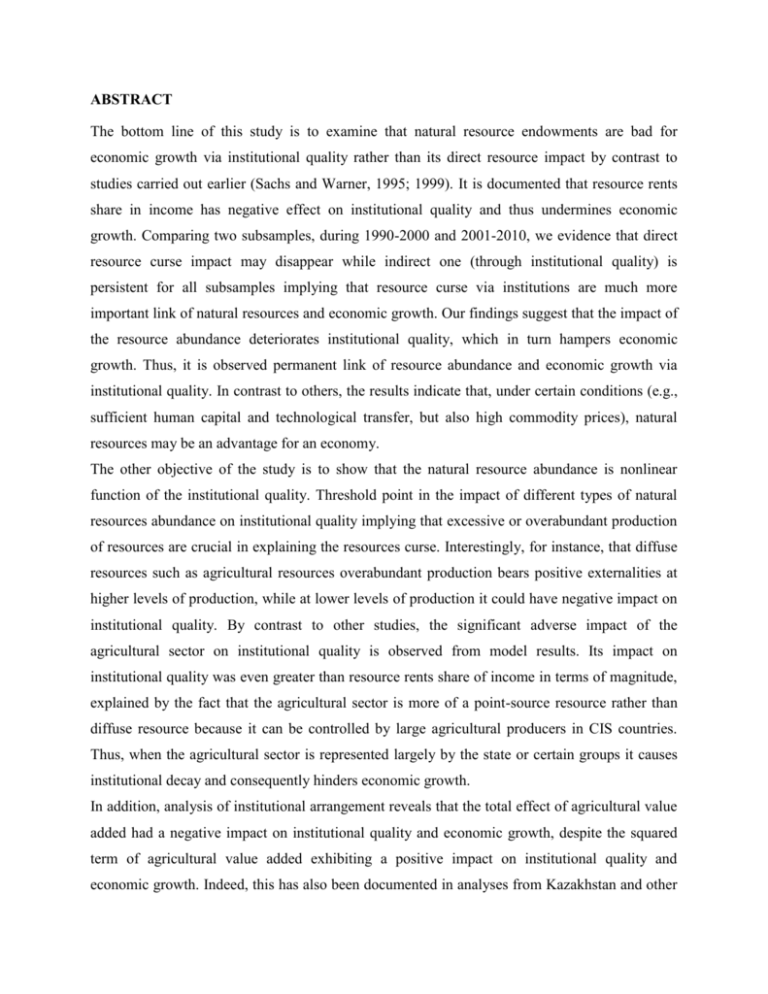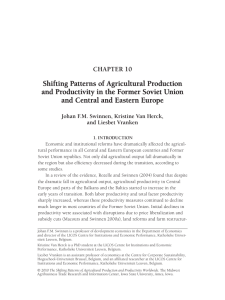rather institutional
advertisement

ABSTRACT The bottom line of this study is to examine that natural resource endowments are bad for economic growth via institutional quality rather than its direct resource impact by contrast to studies carried out earlier (Sachs and Warner, 1995; 1999). It is documented that resource rents share in income has negative effect on institutional quality and thus undermines economic growth. Comparing two subsamples, during 1990-2000 and 2001-2010, we evidence that direct resource curse impact may disappear while indirect one (through institutional quality) is persistent for all subsamples implying that resource curse via institutions are much more important link of natural resources and economic growth. Our findings suggest that the impact of the resource abundance deteriorates institutional quality, which in turn hampers economic growth. Thus, it is observed permanent link of resource abundance and economic growth via institutional quality. In contrast to others, the results indicate that, under certain conditions (e.g., sufficient human capital and technological transfer, but also high commodity prices), natural resources may be an advantage for an economy. The other objective of the study is to show that the natural resource abundance is nonlinear function of the institutional quality. Threshold point in the impact of different types of natural resources abundance on institutional quality implying that excessive or overabundant production of resources are crucial in explaining the resources curse. Interestingly, for instance, that diffuse resources such as agricultural resources overabundant production bears positive externalities at higher levels of production, while at lower levels of production it could have negative impact on institutional quality. By contrast to other studies, the significant adverse impact of the agricultural sector on institutional quality is observed from model results. Its impact on institutional quality was even greater than resource rents share of income in terms of magnitude, explained by the fact that the agricultural sector is more of a point-source resource rather than diffuse resource because it can be controlled by large agricultural producers in CIS countries. Thus, when the agricultural sector is represented largely by the state or certain groups it causes institutional decay and consequently hinders economic growth. In addition, analysis of institutional arrangement reveals that the total effect of agricultural value added had a negative impact on institutional quality and economic growth, despite the squared term of agricultural value added exhibiting a positive impact on institutional quality and economic growth. Indeed, this has also been documented in analyses from Kazakhstan and other CIS countries. This is an implication that the agricultural sectors are dominated by state or large agricultural enterprises in these countries, and in this sense the sector can be regarded as a pointsource resource sector. The dominance of large agricultural enterprises or state companies has negatively influenced the progress of reforms; for instance, land property rights are not enacted or established in almost all of the CIS countries. In this regard greater transparency and political accountability in the management of specific resources is the most significant policy recommendation resulting from this investigation, given that a lack of transparency makes point-source and diffuse resources production appropriable by rent-seeking entities and prone to inefficient utilization. In addition, overly complicated rules and regulations enhance opportunities to extract bribes. Increase in the number of small- and medium-sized farms would initiate competition, especially in the agricultural sector, consequently eliminating the domination of large-scale agricultural enterprises. In turn, this would entail an environment that is more responsive to reforms such as ensuring land property rights, which would help undermine the position of elites and their resistance to democratic reforms.








